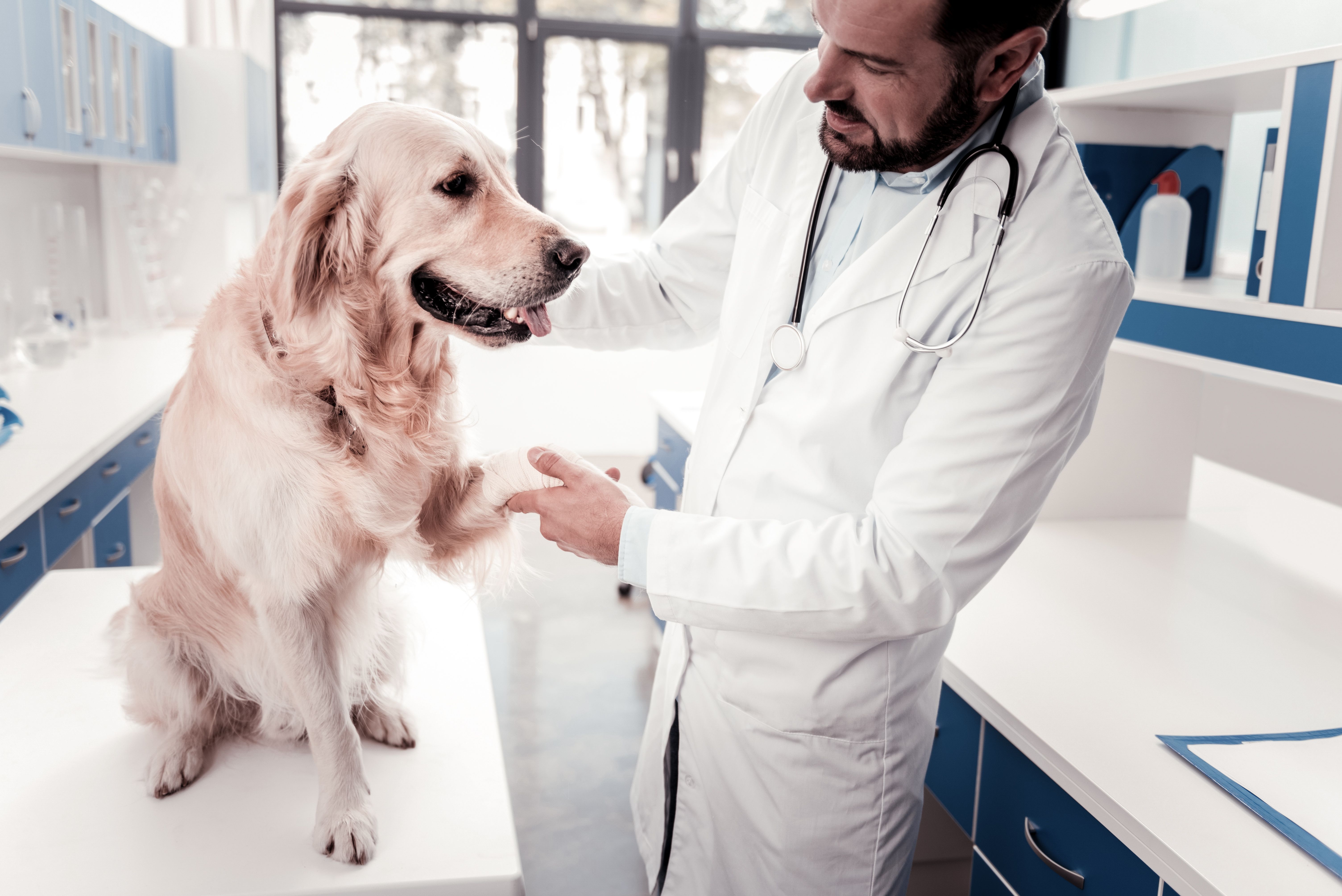Read this before performing your next veterinary orthopedic exam
There’s no single way to practice veterinary medicine or perform orthopedic exams, but these tips will serve you well in your quest to achieve the best possible patient outcomes.
Viacheslav Iakobchuk / stock.adobe.com

Whether you see limping patients every day or infrequently, it’s never too late to refine your exam techniques and diagnostic procedures. During a lively, interactive keynote session at the Fetch dvm360® virtual conference this weekend, Courtney Campbell, DVM, DACVS-SA, who practices at VetSurg in Ventura, California, incorporated video clips and anecdotes to explain 5 pearls of wisdom that can help veterinarians improve our approach to orthopedic exams.
Remember neuropathic pain
When performing an orthopedic exam, it may seem logical to focus on muscles, joints, bones, tendons, and ligaments. But how often do those exams fail to identify a reason for the patient’s lameness? Campbell reminded attendees that neuropathic pain is a common, underdiagnosed cause of lameness. “About 50% to 60% of my patients that come in for an orthopedic condition have a component of neuropathic pain,” he said, adding that diagnosing neuropathic and orthopedic pain simultaneously is still an emerging field in human and veterinary medicine.
This condition can cause spontaneous or paroxysmal pain, allodynia, and other clinical signs; and it can result from intervertebral disk disease, trauma, abnormal conformation, neoplasia, immune-mediated disease, and other conditions. Although various nerves can be associated with neuropathic pain, Campbell noted that sciatic and radial nerve pain are 2 important conditions to check for.
To detect sciatic nerve pain during a physical exam, use the thumb to apply deep pressure between the biceps femoris and semitendinosus muscles, along the popliteal fossa. Radial nerve pain can sometimes be isolated by deep palpation of the tricep muscle bellies directly behind the shoulder joint. Campbell also advised palpating the lumbar, lumbosacral, and tail base areas for signs of pain. Evaluate the cervical region by taking the neck through range of motion and apply digital pressure. “To help avoid overlooking the possibility of neuropathic pain, it’s important to evaluate every animal for the presence of paraspinal, sciatic, and radial hyperpathia,” Campbell said.
Following the physical exam, radiography can further elucidate causes of neuropathic pain (sedation may be needed). Referral to a neurologist for magnetic resonance imaging and electrodiagnostic testing can also benefit some patients. Management options for neuropathic pain include such medications as gabapentin, pregabalin, amantadine, and amitriptyline. Campbell also recommends developing a good working relationship with a neurologist to facilitate diagnostic and therapeutic cooperation that benefits patients.
Use a composite approach when checking for cruciate ligament injury
Cruciate ligament disease is the most common orthopedic condition in dogs, costing over $1 billion annually, Campbell said. Diagnosis can be a challenge, however, because eliciting the drawer sign and conducting other routine assessments aren’t always conclusive. Campbell noted that diagnostic success can depend on both the technique used and the execution of that technique. When trying to elicit drawer, improper hand position, bending the wrists, not being assertive enough, sliding the patient’s skin instead of the body structures underneath, failing to assess range of motion, and other technique glitches can limit the effectiveness of the exam, he cautioned.
Instead of relying on a single procedure, Campbell recommends a composite approach, using a combination of properly executed techniques to evaluate the knee joint before deciding whether the cruciate ligaments are damaged. Techniques like the cranial drawer test, parapatellar palpation, positive sit test, tibial compression test, and assessing the stifle in hyperextension can all add relevant information, especially when executed properly and used concurrently.
Take comparison radiographs
When evaluating radiographs, Campbell warned, “there’s tremendous diversity among dogs. With so much variation, it can be hard to know what’s pathologic and what’s not.” He further noted that incidental findings, normal anatomic variations, and open growth plates (in juvenile patients) can look like pathology when they really aren’t. Taking comparison radiographs of the opposite leg can help identify normal anatomic variations that may be incidental findings for a patient and reduce the chances or misdiagnosing a normal variant as pathology.
To improve detail, Campbell also advises collimating the x-ray beam and centering it properly over the area of interest.
Remember that cats are different
Campbell recognized that orthopedic exams in cats are different for several reasons. Cats tend to display pain differently than dogs do, cat owners may have a harder time recognizing pain, and cats need special handling in a clinic setting. “Cats rarely come in for orthopedic lameness,” he said. “But when they do, you’ll likely find something. So, if you see a cat limping, there’s likely a problem.”
When reviewing the medical history, it may be helpful to ask different question of cat owners. Campbell said that cats experiencing pain at home may be reluctant to jump, jump shorter distances, or show reluctance to use stairs. Hiding, appetite loss, and changes in personality can also be indicators of pain in cats. “It’s important to get a thorough history and ask a lot of questions,” he said.
Once in the office and out of the carrier, conducting gait analysis is different for cats, because they’re often too stressed and nervous to walk around in the exam room.Campbell likes to clear an area in the center of the room, but create a dark/covered spot (eg, under a chair, or placing an open carrier in a corner) in a corner. Some cats will walk from the center of the room over to the dark area. “Sometimes, a few steps are all you’ll get,” he said. Another method Campbell likes is to shine a laser pointer or flashlight on the floor to see if the cat will take a few steps to play with it. It may expedite the exam if pet owners record video of the cat’s lameness at home, where the cat is more relaxed and therefore more likely to display signs, he offered.
Stressed or anxious cats are likely to be more resistant to examination. A quiet exam room environment can encourage them to relax. Towels can facilitate restraint and handling, but some cats are better with sedation. Campbell noted that gabapentin and trazodone won’t influence pain response during the exam, so they are good choices for patients that need it.
The actual exam for cats is slightly different, too. “We know that bite wounds in cats are the most common cause of lameness, so I check the long bones for heat, pain, and swelling,” Campbell said. Other things to assess include crepitus, muscle mass and limb asymmetry, and moving the limbs and joints through range of motion. Lumbosacral disk disease is underdiagnosed in cats, so it’s essential to remember to check the length of the back for pain.
To splint or not to splint: making the right call
External coaptation is a good option for some fractures, especially for pet owners who can’t pursue surgery. However, case selection has a critical impact on treatment success. Campbell urged attendees to consider patient, fracture, and owner characteristics when deciding whether a splint is the best option for a patient.
Patient characteristics include things like size (giant-breed dogs can be difficult to splint). Older dogs may not heal well, and greyhounds’ thin skin may not tolerate bandaging well. Additionally, some chondrodystrophic dogs do better with surgery, simply because the conformation of their limbs can make external coaptation more difficult. Also consider whether an owner will have difficulty maintaining and monitoring a splint.
Finally, the nature of the fracture is a key factor. Some fractures, such as greenstick fractures and nondisplaced or minimally displaced long bone fractures, may heal well after splinting. Campbell added that only long bone fractures that are below the elbow or stifle are readily amenable to splinting. “You can barely immobilize the femur. Even if you take the splint above the hip, you’re not immobilizing the femur,” he said. Comminuted and peri-articular fractures also do better with surgical correction.
